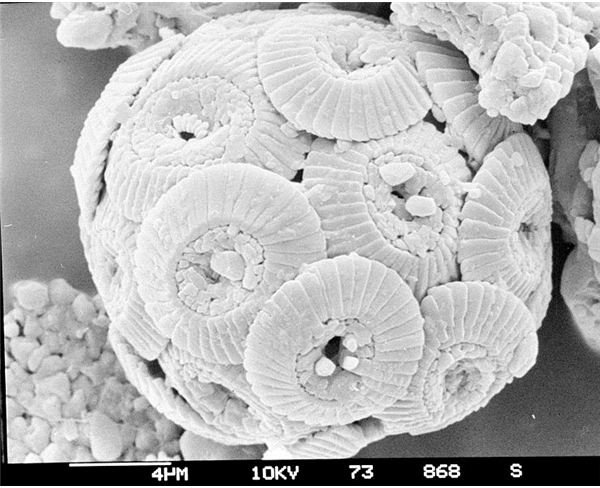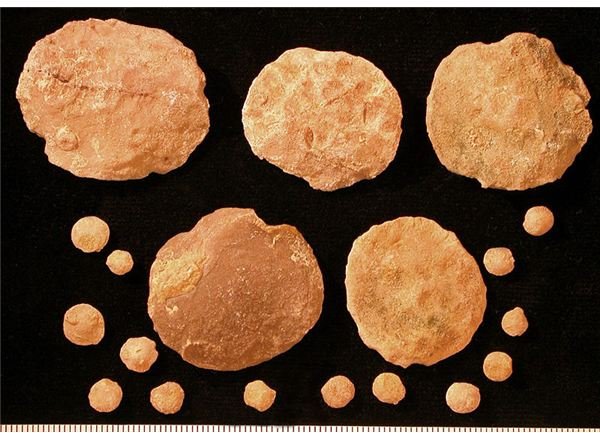Fossils in the Deep Sea and Types of Fossils in the Arctic
Foraminifera Fossils in Deep Sea Cores Show the Cretaceous/Tertiary Mass Extinction
Fossils in the deep sea oceans are found in deep sea cores. Two major drilling projects are Deep Sea Drilling Project (DSDP) and the Ocean Drilling Program (ODP). These drilling projects began in the 1960’s. Specialized vessels drill sediment core samples under the sea. First they lower a drill 6000 meters or more to the bottom of the sea. A hollow pipe takes out a long cylinder of sediment in the ocean floor; this cylinder can be up to 500 meters long. The deep sea core contain fossils of marine animals,
sand, volcanic glass and other materials which gives a lot of information about what happened many million years ago.
One of the most common fossils in the deep sea cores are species of Foraminifera. These one celled organisms first evolved 500 million years ago in the earliest Cambrian Period. There are several thousands of species of Foraminifera and some species live only in very specific environments. Many of them have tests - a shell made of calcium which makes them easily fossilized. Their shell contain information about the environment that they lived in, and among other things they can be used to study the climate changes the last millions years. The Geological Time Period can easily be determined by analyzing the species diversity of Foraminiferians in a layer, as many species only lived for a short time period. This information is very valuable for oil drilling companies, who uses them to find oil deposits.
An interesting example from The Ocean Drilling Program (ODP) is, cores that contain information about the asteroid that hit earth 65 million years ago and triggered the Cretaceous/Tertiary mass extinction. In the core are fossils of Foraminifera from both before and after the impact of the asteroid, and the Foraminifera fossils after the asteroid impact are smaller, showing how the asteroid changed the environment and caused the extinction of species. The core also has dust and ash from the impact itself.
Tiny Coccoliths are Used for Age Determination of Very Small Samples
Other fossils in the deep sea cores include Diatoms, Dinoflagellates, Silicoflagellates and Coccoliths. Diatoms are

single-celled algae, and Dinoflagellates and Silicoflagellates are single celled protists.
Coccoliths are tiny plates made from calcium produced by unicellular marine algae, the Coccolithophorids. The Coccoliths and Nannoliths (small calcite bodies of unknown origin, but related to Coccoliths) are also called calcareous nannofossils. The small size allows for age determination of very small samples. They are found from the Jurassic Period through to Pleistocene.
All these microfossils are like Foraminifera species used to date the layers of sediment and to gather information about the environment.
Types of Fossils In the Arctic are Used to Study Climate Changes
Fossils in the deep sea are also valuable in studying climate changes on a geological time scale, and these types of fossils in the Arctic are used to look at climate changes.
By studying the composition of species of Dinoflaggelate cysts occurrence in sediment layers in the Arctic Ocean, scientists can infer changes in temperature. During the interglacial periods when the water is much warmer there are more species of Dinoflaggelates and other microfossils. When the Arctic is covered with ice during an ice age, there are less species. For instance during the transition to Holocene - the Geological Epoch that began approximately 10000 years ago and continues today - there are a high concentration of Dinoflaggelates fossils in the sediment. The Holocene is an interglacial and therefore a warmer period with inflow of warm water from the Atlantic Ocean to the Arctic Ocean.
In summary micro-fossils such as Foraminifera and Dinoflaggelate species are types of fossils found in deep sea cores and and in the Arctic. The concentration and kind of species of these microfossils tells us what their environment was like, and helps us understand major events in the Earth’s history. Events such as the asteroid impact that led to the Tertiary / Cretaceous mass extinction and the unset of ice ages and interglacial periods.
References
Bolli H. M., Saunders J. B. and Perch-Nielsen K. Plankton stratigraphy: Planktic foraminifera, calcareous nannofossils and calpionellid. Cambridge University Press 1985. https://books.google.co.za/books?id=Y888AAAAIAAJ
Lamont-Doherty Earth Observatory Columbia University: https://www.ldeo.columbia.edu/res/fac/CORE_REPOSITORY/RHP5c.html
Matthiessen J., Knies J. Nowaczyk N.R.,Stein R. “Late Quaternary dinoflagellate cyst stratigraphy at the Eurasian continental margin, Arctic Ocean: indications for Atlantic water inflow in the past 150,000 years” Global and Planetary Change No 31 2001 pp. 65–86: https://www.ngu.no/glacipet/photos/internal/pdfs_of_articles/Mathiessen_QUEEN_GPC.pdf
NASA Earth Observatory: https://earthobservatory.nasa.gov/Features/Paleoclimatology_SedimentCores/paleoclimatology_sediment_cores_2.php
Ocean Drilling Core Legacy: “A Blast From the Past”: https://www.odplegacy.org/PDF/Outreach/Education/BlastfromthePast.pdf
University Of California Museum of Paleontology: https://www.ucmp.berkeley.edu/fosrec/Wetmore.html
“Reports on Deep Earth Sampling and Monitoring” Scientific Drilling No 9 April 2010. https://www.iodp.org/index.php
Image Credits
Foraminifera Fossils: Wikimedia Commons / Wilson44691
This post is part of the series: All About Fossils
This article series focuses on fossils. It includes a guide to the major groups of fossils, explores which fossils are found in the deserts around the world, describes how deep sea fossils are used to shed light on evolutionary events, explains the fossil record, and describes how fossils are formed
